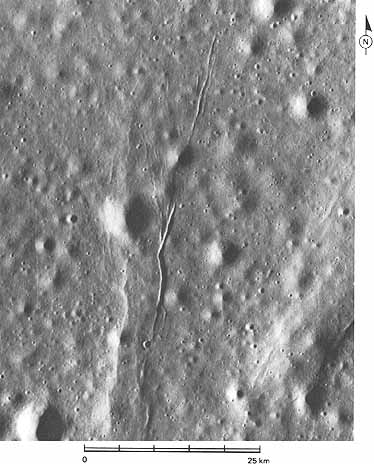
Chapter 6: Rimae (3/3)
Straight Rimae
|
[198] |
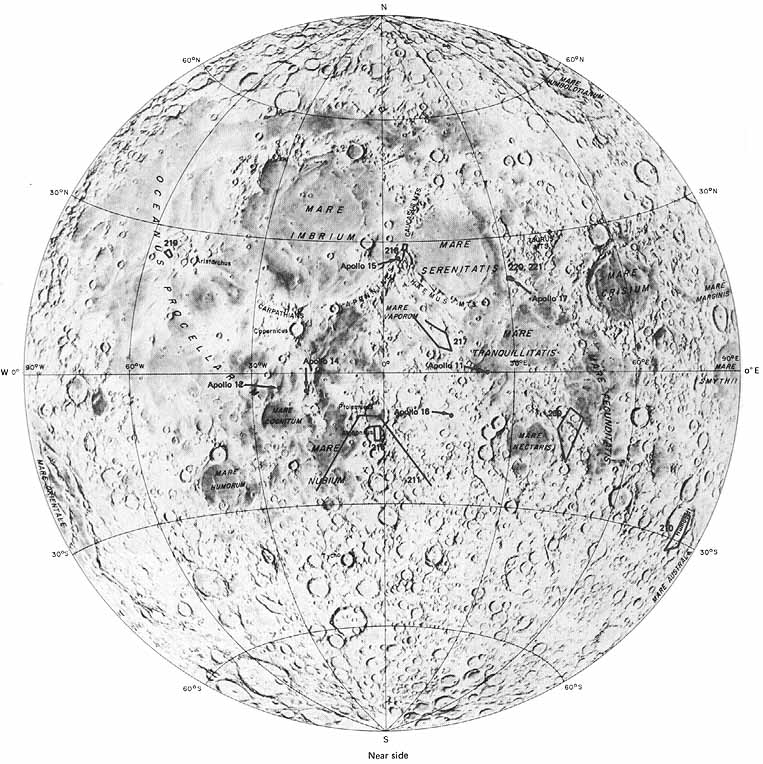 |
[199] In many places the lunar surface is broken and a portion is downdropped, forming trenchlike features known as straight rimae or rilles. Some of these rilles are large enough (tens of kilometers across) to be visible on Earth based photographs; others are so small (a few meters across) that they are barely visible on the highest resolution orbital pictures.
Some of these trenches cut across the surrounding plains, uplands, and craters and may record preferred directions of breakage of the lunar crust caused by internal stresses (the so called lunar grid). Others ring crater floors and may be related to uplift of the floor caused by crustal readjustment after impact. A few contain low rimmed dark halo craters that are interpreted to be volcanic vents. Many trenches are curvilinear; some appear to be transitional between straight rilles and sinuous rilles.-H.M.
|
[200] |
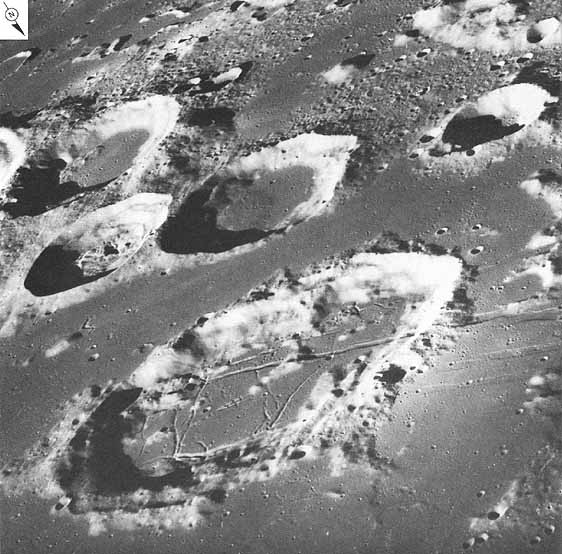 |
FIGURE 209 [above].-This oblique view looks westward over the crater Goclenius (large crater in the foreground) at the western edge of Mare Fecunditatus. The area is typical of the edge of shallow mare basins in that ejecta deposits and interiors of older craters along the margins are partially flooded by mare material. The pitted portions of the intercrater areas in the background are crater deposits that have not been flooded by the smoother mare material. Both the craters and maria are cut by linear rilles (Rime Goclenius I and II); rilles are also seen along other shallow mare basin margins. In this picture, several linear rilles, each about 1 km wide, can be seen crossing from right to left across the mare into the floor of Goclenius. The rilles are thought to be similar to fault bounded troughs on Earth (grabens) and may have originated when the central portion of the mare basin settled. J.W.H.
|
[201] |
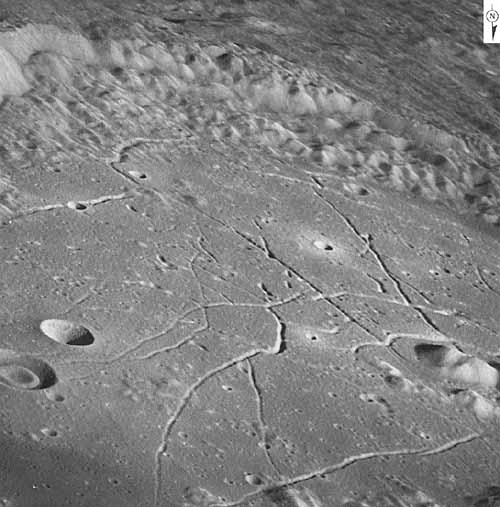 |
FIGURE 210 [above].-This picture of the interior of the crater Humboldt (approximately 200 km in diameter) was taken looking southward. The terraced crater wall lies in the background, and the central peaks are visible in the lower right hand portion of the picture. The crater floor is typical of those that exhibit both radial and concentric cracks, or fissures. The fissures and cracks appear to be related to the uplift of the crater floor subsequent to the formation of the crater. The deformation may be related to upwelling of portions of the crust in an attempt to reach isostatic equilibrium, or it may be coincident with intrusion of lavas below the crater floor. Small patches of dark mare material can be seen along the edge of the crater floor in the lower left and middle right hand portions of the picture.-J.W.H.
|
[202] |
 |
FIGURE 211 [above].-This oblique metric photo shows part of the lunar highlands where the ancient crust is saturated with large craters. Portrayed here are the crater Alphonsus (middle ground) and the ancient crater Ptolemaeus (foreground). The floor of Alphonsus is broken by faults that form a polygon roughly parallel to the walls. Dark halo craters lie along these faults. The rims of the dark halo craters fill in the fault troughs. This relationship indicates that the craters must have been formed by material ejected from the central vents rather than by collapse of material into the cracks. However, unlike impact craters with their hummocky ejecta and lines of secondary craters, the smooth rimmed deposits have been interpreted as finegrained volcanic ejecta.
Lunar transient events have been observed many times in the crater Alphonsus. Red glows have been documented and spectra have been recorded by Kozyrev (1971) that apparently confirm the existence of gaseous emissions. These events are thought to be related to orbital parameters; when gravitational stresses are high, the crust shifts and gas escapes from the interior at regular intervals. If this is true, a low level of activity still continues to affect the lunar crust and interior.
General and detailed contour maps have been made (Wu et al., 1972) of Alphonsus using metric and panoramic photography obtained by Apollo 16. (See figs. 212 to 215. Fig. 212 is outlined in this figure, and fig. 213 is outlined in fig. 212.)-H.M.
|
[203] |
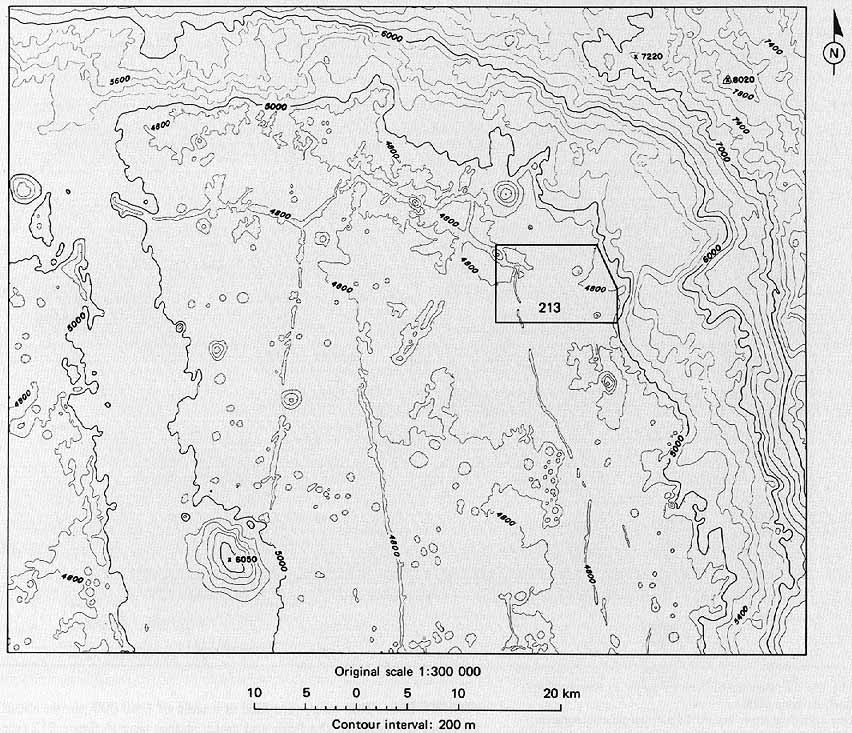 |
FIGURE 212 [above].-This map, compiled of the floor of Alphonsus at a scale of 1:300000 shows an array of faults, volcanic centers, and impact craters. The smooth flanks and youthful appearance of the central peak are apparently the result of the downslope movement of fragmental material that has filled in any impact craters as fast as they formed.-H.M.
[204]
FIGURE 213 [above].-This map, compiled at a scale of 1:40 000, shows about 10 times the detail of the floor and crater shapes seen in figure 212 (see outlined area). The locations of profiles of two dark halo volcanic craters (A A' and B B') are shown on the map.-H.M.
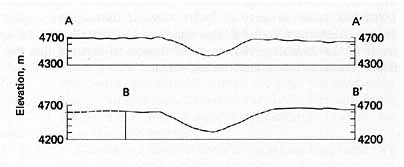 |
|
|
|
[205] |
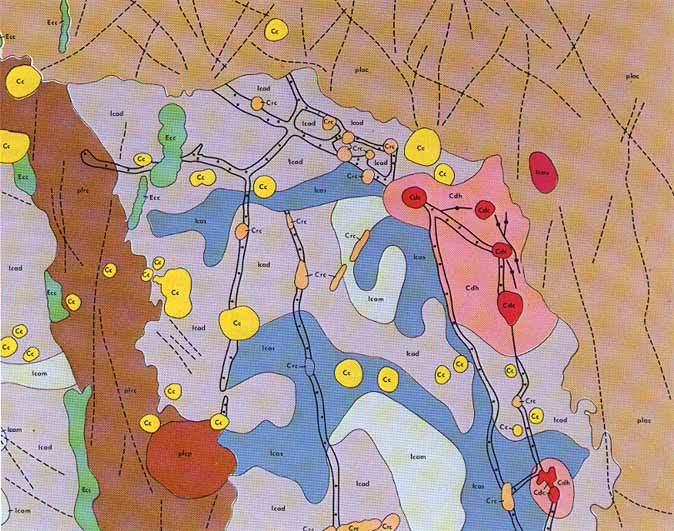 | |
|
|
|
|
|
|
 |
 |
|
|
FIGURE 215 [above].-A sketch geologic map of the area of figure 213 was done by Richard Hereford of the U.S. Geological Survey. It shows the distribution of the geologic units by type and age. The ancient crater walls, central peak and ridge, and varied floor deposits are displayed. H.M. | |
|
[206] |
 |
FIGURE 216 [left].-This oblique view of part of the flat floor of the ancient crater Alphonsus shows faults that break the floor along straight line fractures. Spaced at irregular intervals along some of the rilles are dark halo craters that have broad low rims. The first detailed pictures of these craters were taken by Ranger 9 in 1964. This photograph confirms the detail in the Ranger picture and confirms the hypothesis that the dark halo craters are volcanic in origin. Their constructional rims indicate that they cannot have formed by collapse of material running back into the fault zone. The smooth rim deposits indicate that fine grained material was ejected uniformly from the volcanic vent. These deposits differ markedly from the ejecta patterns around bright, young impact craters.-H.M.
|
|
[207] FIGURE 217 [right].-Rima Ariadaeus is a fine example of a straight rille. Ariadaeus Rille is over 300 km in length; a portion of the central section of the rille about 120 km in length is pictured here. A linear section of the crust is dropped down along parallel faults or breaks in the crust to form a graben or fault trough. The ridges crossing the trough and the surrounding plains units have been offset by the trough, proving that they are older than the faults. Some craters are cut off by the faults and are, therefore, older. Other craters lie on the wall of the trough and are younger than the faulting. The faulting must be relatively young because so few craters appear to be younger than the faults, and because the edges of the trough appear to be crisp and little affected by slumping and other mass wasting. There is a gradation between straight rilles, gently curving rilles, and sinuous rilles modified by volcanic flows. This example shows no trace of associated volcanism; it is, therefore, considered to be the end member of the sequence, where only pure faulting is involved.-H.M.
|
 |
|
| |
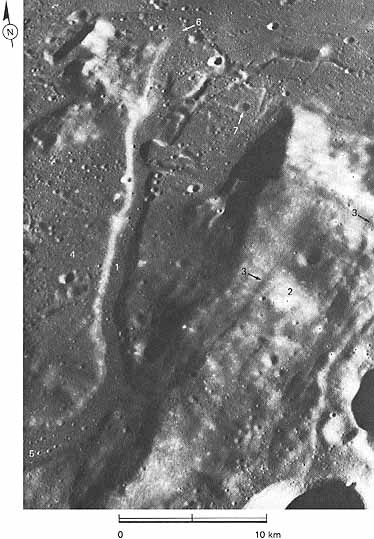 |
FIGURE 218 [left].-Rima Fresnel I (1) approximately parallels the Apennine Mountain front (2) along the eastern margin of the Imbrium basin. The rille and its several branches at the northern end fall into the class of linear rilles that are usually attributed to a ten signal structural regime causing the formation of grabens. Faults in the highlands (3), parallel to some of the rilles, support the contention of structural origin for the rilles. Some of the curvilinear segments of the rilles, however, suggest that they may have served locally as lava channels. The rille traverses a plain that was called the Apennine Bench (4) and interpreted to be formed of older mare lavas (Hackman, 1966). The inside of the rille is flooded by younger mare lavas (Carr, Howard, and El Baz, 1971) (5), which also embay its northern truncated terminus (6). Some younger mare lavas may have poured over the bench material and buried a crater (7). Old lava benches on the inside margin of basins are a common feature on the Moon. They are usually crossed by old rilles and embayed and partially buried by younger lavas.-B.K.L.
|
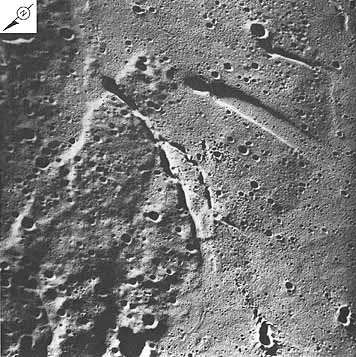 |
[208] FIGURE 219 [left].-A low Sun angle view of the western part of the Aristarchus Plateau shows three sharprimmed linear depressions that occur in the higher unit and terminate at the edge of the plateau. Their floors are filled with mare material that is similar to the surrounding materials of Oceanus Procellarum (lower right corner). The chain of craters in the mare of Oceanus Procellarum is believed to be secondaries from the crater Aristarchus (outside of the view). As described by Alfred M. Worden, the Apollo 15 CMP, the mare materials in this region display a brownish tint, as compared to the metal gray materials of Mare Imbrium farther east.-F.E. B.
|
|
| |
|
|
FIGURE 220 [left].-Some of the freshest and youngest fractures yet found are in the Littrow area. The sharpest gash in this view runs along the right side of one of the much older Littrow rilles. The surface material in this area appears to be soft; blocks are very rare and most craters appear subdued. Therefore, it seems likely that the fresh fractures here, which are smaller than those in the preceding figures, will not survive long before they are obliterated by mass wasting.-K.A.H.
|
|
[209] |
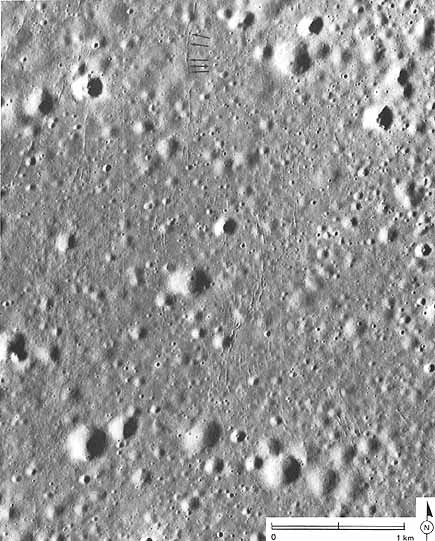 |
FIGURE 221 [above].-This detailed view of a mare surface near the eastern edge of Mare Serenitatis, just west of the Apollo 17 landing site, shows the numerous small grooves. They are unusual features that have not been observed in such large numbers elsewhere. They are here developed in a thick accumulation of regolith overlying an ancient mare basalt. At first glance, resembling chains of secondary impact craters, they are more logically interpreted as structural features. A likely explanation is that they are the result of drainage of unconsolidated regolith into openings caused by fissuring in the consolidated bedrock. At some localities, drainage did not occur at a uniform rate along the fissure but was concentrated at certain points, resulting in a series of unequally spaced, pitlike depressions (arrows) along the groove.-B.K.L.
| Next |

